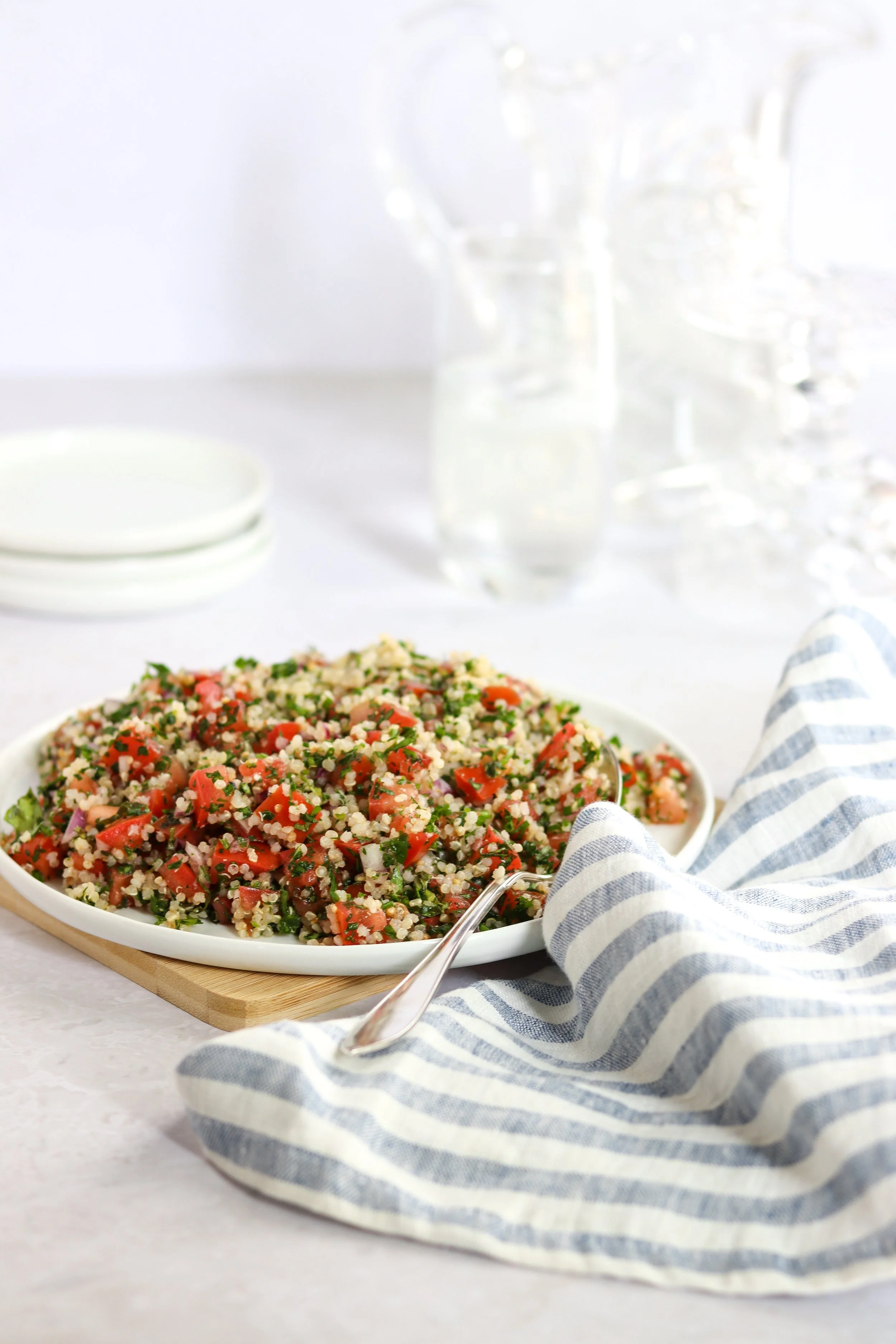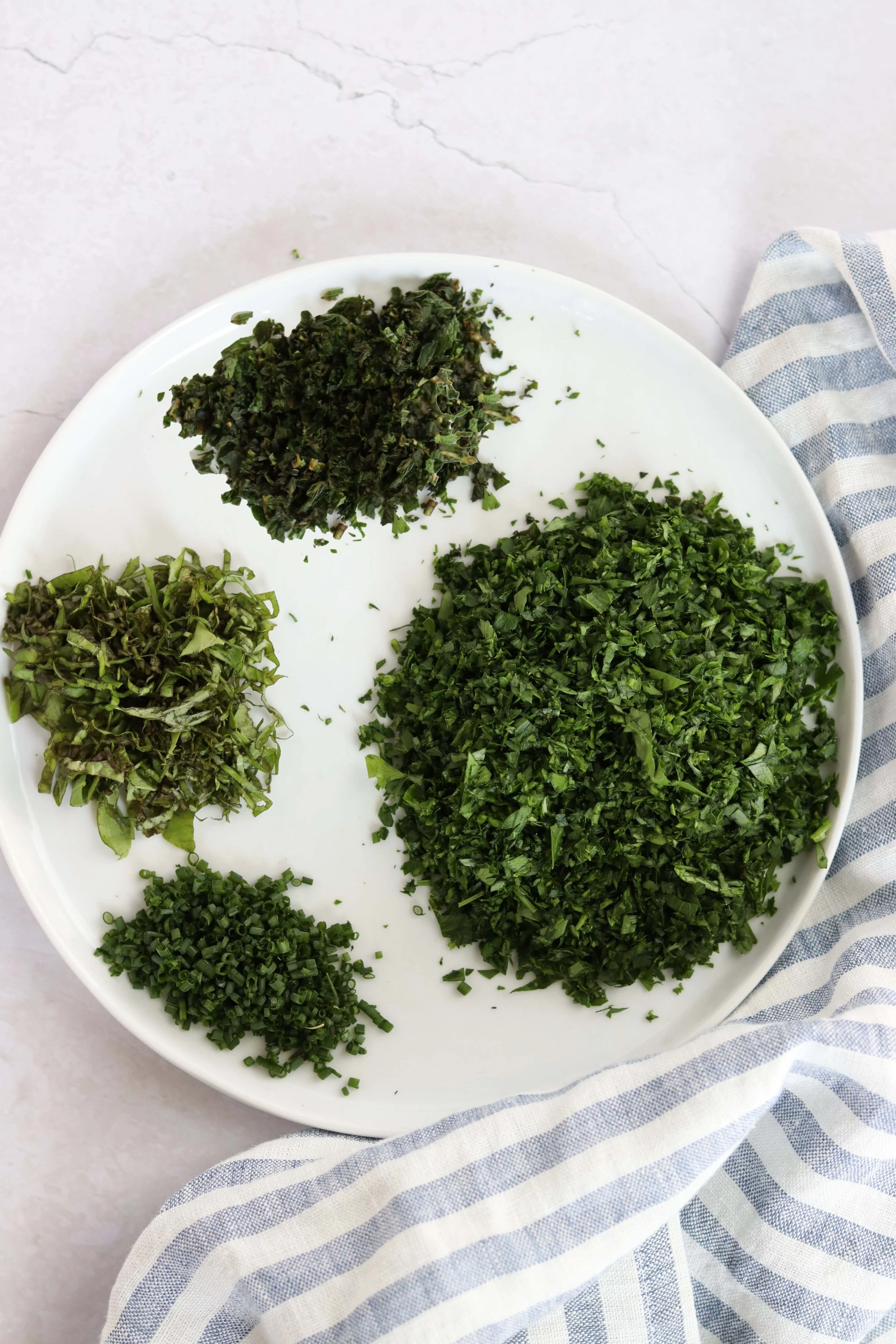Quinoa Tabbouleh (Tabouli Salad)
It’s an insult to call this a “salad.”
I say this because a salad can carry a somewhat negative connotation. “Healthy” evokes an image of dull, floppy outer leaves of an old head of iceberg lettuce torn into a bowl. That’s it. Nothing else. Maybe a carrot if one has time. The simplest, saddest form of a salad instills feelings of disappointment. There is nothing comforting or satisfying about a dry, flavorless plate of water. As a salad enthusiast who eats at least one salad a day (but never a sad salad), I still envision this startling representation of greenery when I think of a typical salad. Though green is the dominant color in tabbouleh, this salad is a harmony of complexity and sophistication, and also stands as a symbol of simple tradition. Staple ingredients like tomatoes, fresh herbs, lemons, and grain all tossed together reminds you that good-for-you food is fresh and familiar.
I had a friend whose parents were immigrants from Lebanon and Syria. After a sleepover, my friend and I were woken up by the aroma of fresh garlic steeping in olive oil. We would walk down the stairs to be bombarded by bunches and bunches of parsley and cilantro covering the kitchen island, waiting to be chopped and added to dishes during the week. That is why I don’t associate tabbouleh with traditional leaf-based salads. These flavors and preparations established a greater appreciation for a culture and its people.
What is Tabbouleh?
defn: tabbouleh/ tabouli (n)- a Middle Eastern salad consisting of cracked wheat with finely chopped ingredients such as parsley, mint, and tomatoes tossed with olive oil and lemon juice
Tabbouleh is said to have originated in the mountainous regions present-day Lebanon, Syria, Palestine, and Jordan. The name “tabbouleh” stems from the Arabic “taabil” meaning “to season.” Essentially a parsley salad, tabbouleh is predominantly made up on herbs that were grown on the hillsides and abundantly available for people. Eventually, grain was added for additional heartiness and texture. It is commonly served alongside meats and fish as a side dish. Today, vegans and vegetarians alike enjoy tabbouleh. Many Eastern Mediterranean restaurants serve this vibrant salad as a side dish to accompany spiced and grilled meats, creamy hummus and baba ghanoush, and a variation of a flatbread.
What is the difference between Tabbouleh and Tabouli?
Nothing.
Ingredients in Quinoa Tabbouleh Salad
While developing my own version of this flavorful herb salad, I wanted to make sure that my slight swaps didn’t drastically sway from the traditional tabbouleh. Here’s what I did:
Swapped:
Quinoa for Bulgar- The classic grain found in tabouli is bulgar- a cracked parboiled groat from durum wheat. It is a staple in Middle Eastern households since it is versatile. It can be added to soups and casseroles, and is nutrient dense. It is high and fat and is backed with a substantial amount of protein. Bulgar is simply simmered in water or broth to cook, and the final product still has tooth that adds texture to dishes. Unfortunately, bulgar is a wheat product. Therefore, it is not gluten free or suitable for people with celiac disease. Instead, quinoa is used in place of bulgar in this recipe. Like bulgar, quinoa is high in fiber and packed with protein, and tastes very similar. It adds a nuttiness and a heartiness to the tabouli, so it is a near identical replacement. I personally don’t have bulgar in my pantry, but I always have quinoa on hand. I am sure another similar grain would work, too.
Red Onion for Scallions or Green Onions- I am not the biggest fan of green onions, so I try to use them sparingly in my recipes. I especially like to avoid them in raw applications. If you like scallions, you can swap out the red onion in this recipe for the same amount (or more) of green onions. I love the purple color red onion adds to the salad, so I decided to add red onion instead. White or yellow onion would also work.
Tip: If your onions are potent and you don’t want the strong flavor to overpower the salad, soak cut onions in ice water for up to 5 minutes to mellow the bite. Remove from the ice water and dry well before adding to the tabouli. This also works in other salads and dishes when raw onions can overwhelm other flavors.
Added:
Chopped Fresh Basil and Chives- I won’t eat spinach, but I will eat basil leaves by the forkful. Basil is untraditional, but I love the bright, floral flavor fresh basil adds to a dish. Chives grow so tall in my garden pot during the summer that I have to pick the flourishing pink flowers off the tops and cut them down so that they can continue to grow. Chives add a delicate onion-y flavor (and more green color) to the salad.
Kept:
Parsley- It is a parsley salad after all! You will need the whole bunch of parsley. It may look like an overwhelming, obscene amount initially, but it will amount to less as it is finely chopped down into a small pile.
Mint- Personally, I do not like mint in my dishes, especially in savory dishes. However, to my surprise, the flavor is not overpowering at all.
Tomatoes- The pop of red adds a burst of color, plus acidity and freshness. Use a firm variety like a plum, Roma, or heirloom tomato. I keep the seeds, but you can scoop it out if you prefer.
Garlic- There is nothing like the smell and taste of freshly grated garlic. Grating the garlic releases the juices and oils, and is evenly distributed throughout the salad for a uniform bite. Garlic’s properties also help emulsify the light dressing.
Fresh Lemon Juice- Citrusy, bright lemon juice adds the acidity needed to elevate this dish. I always add more to taste because acid brings out all of the other flavors in the salad and also helps preserve the beautiful bright green color.
Olive Oil- The glue that holds this salad together. This is an excuse to use the fancy extra virgin olive oil that liquid gold in its pourable, drizzle-able form. A high quality olive oil adds a nuance that is unmatched by a neutralized olive oil.
Sea Salt and Black Pepper- Always and forever will I appreciate their reliable service in seasoning every single savory dish ever made by man.
How do I serve Quinoa Tabbouleh?
Quinoa tabouli salad can be served as an appetizer next to creamy hummus (try this recipe for Homemade Hummus) for a Mediterranean-inspired dinner party, or alongside grilled meat such as lamb or beef kebobs during the summertime. It is a simple, nutritious salad that is easy to make anytime of year, but its ingredients are especially vibrant during the summer months.
Tabbouleh can also be made in advance. In the morning or early afternoon, you can prep this tabouli salad, toss it together, and refrigerate it so that dinner is ready and out of the way. You can even bring this salad to a barbecue or a friend’s house as a contribution since it’s light, flavorful, easy to make, and feeds a crowd.
How do I store Quinoa Tabbouleh?
This quinoa tabouli salad is a great dish to meal prep on a Sunday afternoon for an upcoming week’s lunch. It is packed with vegetables, herbs, protein, fiber, and even healthy fats to replenish your energy midday. This salad stays good for about 4 to 5 days sealed well in the refrigerator.
1. In a medium saucepot on medium low heat, toast quinoa until fragrant. Add water. Bring to a boil, then lower to a simmer. Cover and simmer for 10 to 15 minutes until all the water is absorbed. Uncover and let cool.
2. While the quinoa cooks and cools, prepare the other ingreddients for the salad.
3. To a large bowl, add cooked quinoa, chopped herbs, onion, tomatoes, and grated garlic. Lightly toss.
4. Dress the salad with the lemon juice and olive oil and sesaon with salt and pepper. Toss to coat and dress.
Serve immediatly or chill before serving. Keep refrigerated for up to 5 days.





